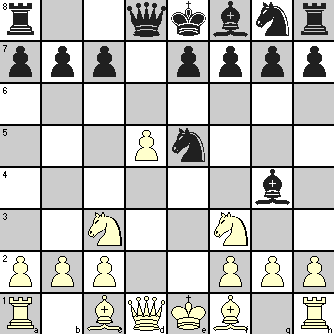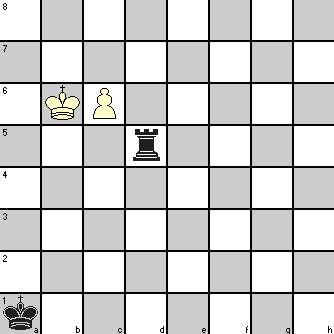
Well, the strategies are good practices which can create advantages to you, but how you convert those advantages into a win depends a lot on your tactics and the quality of your opponent’s play. Concrete examples from master play will give you some idea about what I am saying.
In the first example, try to count the number of violations of the winning strategies in Black’s play! White was a champion of his times, so he immediately hands black a short and sweet (or is it bitter?) lesson and the game is over in the opening phase itself!
Here are the moves:
| 1. | d4 | d5 | ||
| 2. | e4 | Nc6 | ||
| 3. | exd5 | Qxd5 | ||
| 4. | Nc3 | Qd8 | ||
| 5. | Nf3 | Bg4 | ||
| 6. | d5 | Ne5 |
Position after 6 moves.

| 7. | Nxe5! | Bxd1 | ||
| 8. | Bb5+ | c6 | ||
| 9. | dxc6 | Resigns |
Black resigned because heavy loss of material was inevitable.
How many violations of strategies can you identify in black’s play? Did black try to create a supported pawn structure? How many pieces he moved twice in the opening phase? Did he try to develop minor pieces on king side? Did he think of castling? Was he trying to launch a premature attack? Do I make my point?
Now we look at an end game to see the importance of tactics for converting a small advantage into a win (actually a failure to do so). This is one of the classics in chess for tactical lessons.
The boards position was as follows:
8;8;1KP5;3r4;8;8;8;k7 – White to play.
If you don’t understand this short-hand (Forsyth) notation, refer to any basic book on chess or write to us for explaining it. Here is also the diagram to show it.

There are only 4 pieces on board – White king and pawn, Black king and rook. The ‘queening’ threat from the passed pawn neutralizes the rook. So in actual play, the players agreed to a draw after a few moves as it seems that Black’s rook can always be exchanged with White’s pawn (or the promoted queen).
But later analysis showed that White had a winning method available with precision play. First try to find it on your own and if you cannot, take a look at the sequence of moves that gives a win to White.
| 1. | c7 | Rd6+ | ||
| 2. | Kb5! | Rd5+ | ||
| 3. | Kb4 | Rd4+ | ||
| 4. | Kb3 | Rd3+ | ||
| 5. | Kc2! | Rd4! |
White has achieved the position where the pawn cannot be stopped from ‘queening’ and the rook cannot capture it. But Black found a way where he can sacrifice the rook and get a draw through stalemate. If 6. c8=Q then 6. … Rc4+ 7. Qxc4 Stalemate!
But White has a trick up his sleeve …
…6. c8=R!! threatening mate on next move.
If now 6. … Rc4+, White simply plays 7. Rxc4 and there is no stalemate and White mates on next move.
If instead 6. … Ra4, White plays 7. Kb3 and Black cannot handle the twin threat of losing the rook and the checkmate. Quite beautiful, isn’t it?
Remember this theme of under-promotion and keep it in mind before claiming your Queen for a promoted pawn. It may occur rarely, but sometimes this may be the only way to win!


Trackbacks/Pingbacks